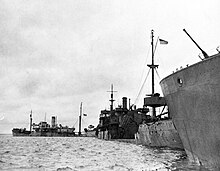
Ryusei Maru was a cargo steamship that was built in England in 1911 and sunk off the coast of Bali in 1944. She was launched as Bra-Kar for Fred. Olsen & Co. of Norway. In 1916 she changed owners and was renamed Havø. In 1935 she changed owners again and was renamed Mabuhay II.
SS Chenab was a steamship that was built in England in 1911 and scrapped in Scotland in 1953. For nearly two decades she was part of Nourse Line, which carried Girmityas from India to colonies in the Caribbean and the Pacific. In 1914 she was requisitioned for service in the First World War.

USS Argonne was a cargo steamship that was built in Japan in 1916 as Taifuku Maru No. 1. She served in the United States Navy from October 1918 to January 1919. In 1922 a French company bought her and renamed her Calonne. In 1922 an Italian company bought her and renamed her Wally. She was scrapped in Italy in 1935.
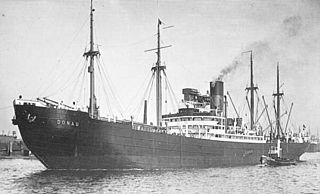
SS Donau was a Norddeutscher Lloyd (NDL) refrigerated cargo steamship that was built in Germany in 1929 and sunk in occupied Norway in 1945. In the 1930s she sailed mostly between Bremen and the West Coast of the United States via the Panama Canal.

The first USS Auburn (ID-3842) was a steam turbine cargo ship of the United States Shipping Board that was built in 1919 and scrapped in 1934. In 1919 she briefly served in the United States Navy.

USS Howick Hall (ID-1303) was a cargo steamship that was built in Scotland in 1910 and served in the merchant fleets of the United Kingdom, United States, Italy and Panama. She served in the United States Army in 1917–18 and then the United States Navy in 1918–19. The United States Maritime Commission bought her in 1941, and a German air attack sank her in 1942.

USS General W. C. Gorgas (ID-1365) was a cargo liner that was launched in Germany in 1902 as Prinz Sigismund for the Hamburg America Line. In 1917 the USA seized her and renamed her General W. C. Gorgas. In 1945 she was transferred to the Soviet Union, which renamed her Mikhail Lomonosov. She was scrapped in March 1958.
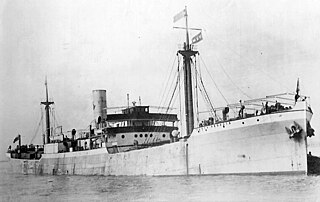
USS Santa Rosalia (ID-1503) was a cargo steamship that was built in Scotland in 1910 and served in the merchant fleets of the United Kingdom, United States and Greece. She served in the United States Navy in 1918–19. She was renamed Stefanos Costomenis in 1929 and sank in the North Atlantic in 1936.

SS Polar Chief was a merchant steamship that was built in England in 1897 and scrapped in Scotland in 1952. In her 55-year career she had previously been called Montcalm, RFA Crenella, Crenella, Rey Alfonso, Anglo-Norse and Empire Chief. Early in the First World War she spent eight months pretending to be the battleship HMS Audacious.
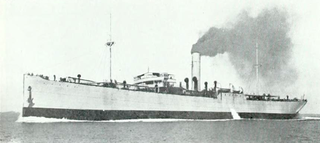
USS Eastern Shore (ID-3500) was a cargo steamship that was built in Japan in 1918 for the United States Shipping Board (USSB). From December 1918 to May 1919 she spent six months in the United States Navy. She was scrapped in 1935.
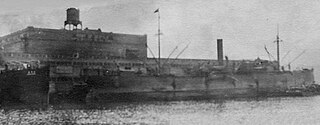
USS Eastern Queen (ID–3406) was a cargo steamship. She was built in Japan in 1918 as Tofuku Maru, and bought that year by the United States Shipping Board (USSB), who renamed her Eastern Queen. From October 1918 to April 1919 she spent six months in the United States Navy as USS Eastern Queen, carrying cargo between the East Coast of the United States and France.
SS Binnendijk was a Holland America Line (NASM) cargo steamship. She was one of NASM's "B" class ships: the company's first cargo ships to be powered by steam turbines. Binnendijk was built in South Holland in 1921, and sunk by a mine in the English Channel in 1939. She was the first ship that NASM lost in the Second World War. Her wreck off the coast of Dorset, England is now a wreck diving site, nicknamed "The Benny".
SS Hertford was a refrigerated cargo steamship that was launched in Germany in 1917, seized by the United Kingdom in 1920 as World War I reparations, and sunk by a U-boat in 1942 with the loss of four members of her crew.
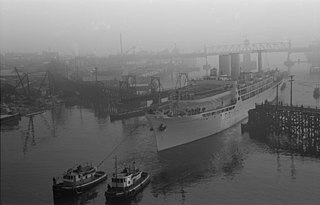
HMS Menestheus was originally the Blue Funnel Line refrigerated cargo ship Menestheus. She was built in 1929, and traded between the UK and the Far East. She was an auxiliary minelayer from 1940 to 1943. In 1945, during the Second World War, she was converted into an amenities ship. She was scrapped in 1953 after being gutted by fire.

SS Rio Tercero was a cargo steamship that was launched in England in 1912 as Eboe. She was renamed Fortunstella in 1938, and Rio Tercero in 1941. A U-boat sank her in the Battle of the Atlantic in 1942.
SS Algarve was a Danish cargo steamship that was built in 1921 for DFDS. After Germany invaded Denmark in April 1940 Algarve was transferred to the UK Ministry of War Transport. In 1941 an E-boat sank her with all hands in the North Sea.
SS Antonios Chandris was a cargo steamship. She was built in Japan in 1918 as Easterling, and renamed Antonios Chandris when she changed owners in 1937. A German merchant raider sank her in the Atlantic Ocean in 1940. 32 of her crew survived a month in two lifeboats before being rescued.
SS Tzenny Chandris was a cargo steamship. She was built in Japan in 1920 as Eastern Planet, and renamed Tzenny Chandris when she changed owners in 1937.
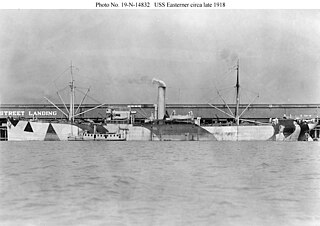
SS Mari Chandris was a cargo steamship. She was built in Japan in 1918 as Seifuku Maru No. 20, and bought that year by the United States Shipping Board (USSB), who renamed her Easterner. From November 1918 to May 1919 she spent six months in the United States Navy as USS Easterner (ID–3331), carrying cargo between the East Coast of the United States and France.
East Indian was a twin-screw cargo ship that was built in Japan in 1918 as Beikoku Maru. The United States Shipping Board (USSB) bought her that same year and renamed her East Indian. The Ford Motor Company bought her in 1925 to transport Ford products overseas. She was sunk in the South Atlantic in 1942. Only 16 of 74 people aboard survived.

